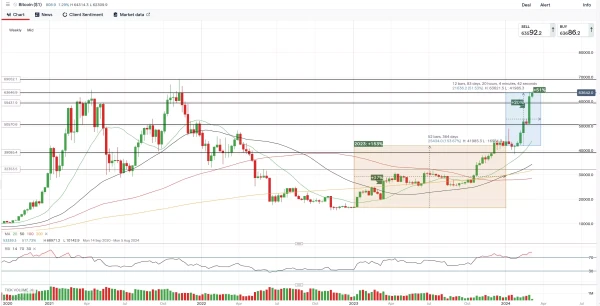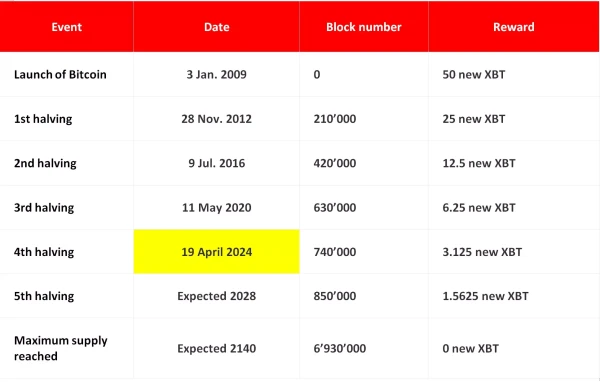Bitcoin eyes all-time-high as crypto frenzy returns
Bitcoin and its companions are making a roaring comeback in 2024, with prices skyrocketing nearly 50% in the first two months. The king of crypto, Bitcoin, has climbed back to its November 2021 highs and is seemingly on track to mark an all-time high in March. What has triggered the explosive demand for the king coin, and how far can it go?
Why Bitcoin prices soar in 2024?
During the past week alone, Bitcoin surged by 20%, reaching a high of USD $64,000, marking its best weekly performance in nearly 12 months and continuing the strong rally that began in early 2023.

The launch of spot Bitcoin ETFs in January 2024 has been the latest catalyst and a major contributor to the explosive demand for Bitcoin.
These ETFs, similar to traditional ETFs, track the price of an underlying asset, in this case, Bitcoin. Unlike directly purchasing Bitcoin, which involves the complexities of cryptocurrency exchanges and managing private keys, spot Bitcoin ETFs are much more straightforward. The underlying Bitcoin is held in secure storage by the regulated ETF provider, and investors can simply buy and sell shares of the ETF through their existing brokerage accounts, just like any other stock. Furthermore, as trading takes place on regulated stock exchanges, it further enhances the security and liquidity of the investment.
The launch of the first eleven spot Bitcoin ETFs hit the market with a bang. The first day of trading witnessed a remarkable $4.6 billion in volume, exceeding expectations and highlighting significant interest in these new investment vehicles. According to Standard Chartered, these ETFs would attract between $50 billion and $100 billion this year.
What is Bitcoin halving?
Another crucial factor that bakes into Bitcoin’s surging prices is an upcoming event call Bitcoin halving. Bitcoin halving is a pre-programmed event that cuts the reward for mining new blocks in half. (As demonstrated in chart below)
This occurs roughly every four years, with the aim to control the supply of new Bitcoins entering circulation. The next Bitcoin halving is scheduled on April 19, 2024.

The direct impact of halving is a reduction in the total number of new Bitcoins in circulation. As shown in the table above, the rate at which new Bitcoins are added has been slowing down year by year.

This reduction in supply is often viewed positively from a long-term perspective, as it potentially contributes to price appreciation due to scarcity dynamics. Additionally, the halving event is poised to change the mining landscape. As the block reward shranks, less profitable miners may be forced to shut down their operations, consequently leading to lower supply and higher mining centralization.
In the short term, the notable impact is the increased volatility of the price. Historically, as evidenced by the preceding three halving events, the first month following the halving has seen an average price increase of 2%, but a more significant rise could be observed in the subsequent six to twelve months.


Summary
While historical observations do not guarantee future performance, it is evident that the upcoming halving event has begun to contribute to short-term price volatility for Bitcoin. Moreover, with the influx of investors from a broader market, thanks to the game-changing spot Bitcoin ETFs, it is not hard to foresee that Bitcoin and other cryptocurrencies will remain in the spotlight in the coming months.